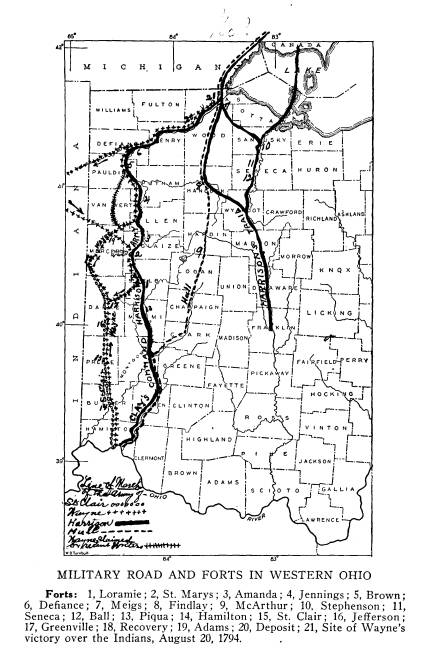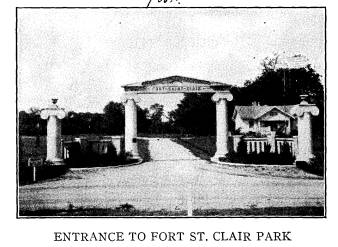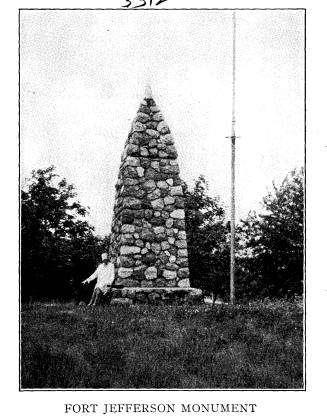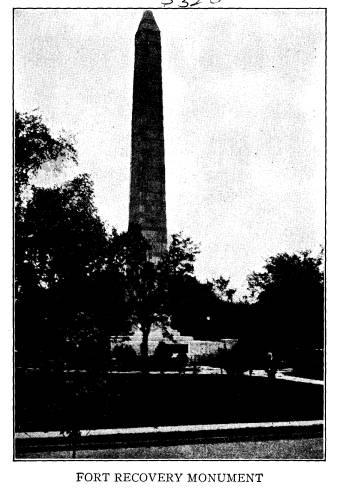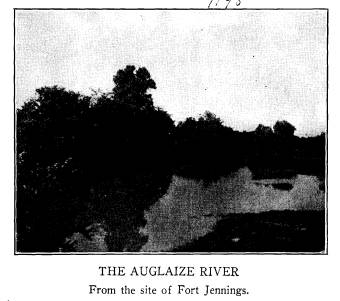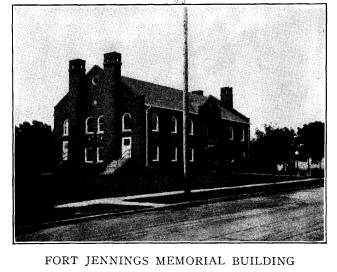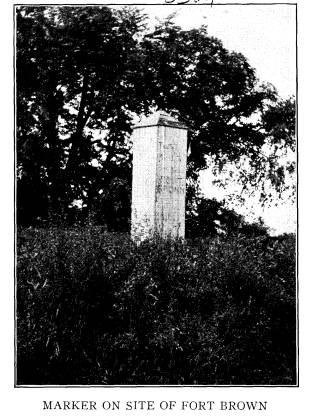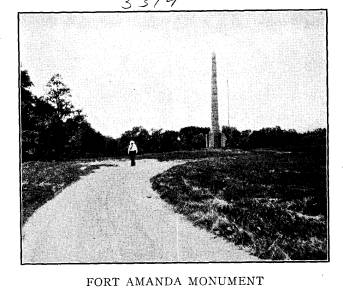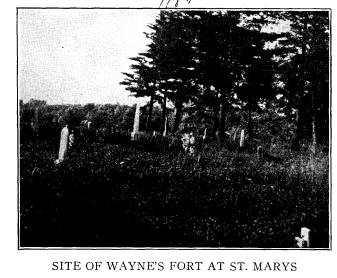Ohio History Journal
A VISIT IN 1929
TO THE SITES, IN WESTERN OHIO, OF FORTS
BUILT BY
GENERALS ARTHUR ST. CLAIR, ANTHONY WAYNE
AND WILLIAM HENRY HARRISON
BY JAMES A. GREEN
CHAPTER I
On the Fourth of July, 1929, I made a
patriotic pil-
grimage, visiting the sites of some of
the forts erected
in western Ohio in St. Clair's and
Wayne's Indian Cam-
paigns and by Harrison in the War of
1812. As showing
the immeasurable difference between the
slow and labor-
ious progress of our early armies and
the speed of the
modern automobile, I left my house in
Avondale - Cin-
cinnati- at 11:00 A. M. on the Fourth,
slept at Del-
phos; from there went to Fort Jennings
and Fort Brown
and returned by way of Paulding and Van
Wert, reach-
ing home at 4:30 P. M. on the fifth.
The distance cov-
ered was 378 miles. Every foot of the
way we were on
a good road and for the most part we
were on cement
and brick highways, smooth and level as
a floor. A speed
of from 40 to 55 miles an hour was quite
safe, and with
the exception of the heavy trucks most
of the cars on the
road were going at about that rate.
The automobile has not yet ceased to be
a marvel.
We still wonder at the way in which it
annihilates dis-
tances. The young people who are not
yet over thirty
take it for granted; they have been
accustomed to it all
their lives, but to men like myself -
who were born in
(601)
602
Ohio Arch. and Hist. Society Publications
the age of the horse and who remember
that if one went
anywhere off the direct line of the
railroad a horse and
buggy represented the fastest thing
there was in the way
of transportation - to such men the automobile is still
a miracle.
When you travel by rail you must go to
the station
and when you reach your destination you
are landed at a
station, probably some distance from
where you wish to
go. But with the automobile you leave
your own house
and it carries you to the exact spot
which you desire, to
the door of the hotel, or to the house
of your friend or
wherever it may be that you are going.
True, the horse
did the same, but by comparison the
horse was so slow
and the horse needed so much
attention-it was neces-
sary to feed and stable it. As for the
automobile, keep
its gas-tank full and give it oil and
water now and then,
barring accidents, it goes on mile
after mile. Like the
Iron Horse it does not grow weary,
uphill or downhill is
the same to its tireless engine. How
many times in the
years gone by I have sat behind a horse
toiling up a long
hill and have suffered to see it suffer
from too much ef-
fort, but the automobile, of course,
does not make any
claim upon your sympathies.
Then, too, the automobile is to be
thanked for the
good roads one finds everywhere and it
seems to me that
it has had an immense effect in making
the country towns
better places in which to live-their
isolation has been
removed. It is noticeable that the hotels
are no longer
"countrified." For example,
at Lima where we stopped
for dinner we were given a table d'hote
meal served in
courses, admirably cooked and quite as
good in every
way as a dinner in New York. And at
Delphos, where
|
|
|
(603) |
604 Ohio Arch. and Hist. Society Publications
one might have expected that the waiter
at breakfast
would have asked the one question of
the old days, "How
will you have your eggs?"-then breakfast
at a country
hotel consisted of ham and eggs, or
eggs in some style,
a small steak, fried potatoes, hot
cakes and syrup and
coffee-at Delphos, they gave us melon,
breakfast food,
buttered toast and coffee.
In the early days travelers dwelt with
some particu-
larity upon the meals they were served,
with unction if
they were good meals and with a display
of ill-humor if
they were poor meals.
I remember well the account John Melish
gives of
passing through West Union in old Adams
County in
1811. He was with an American friend
and it was the
fall of the year. They came to a peach
orchard which
invited Mr. Melish to stop. But his
friend bade him
keep on. Presently they came to another
peach orchard
and here they stopped, for this orchard
had a distillery
attached. So the travelers were able to
purchase peach
brandy and they "found the quality
excellent." A little
later coming to a lovely valley with a
clear stream they
lunched on "a piece of bacon, some
bread, cheese and bis-
cuit," not to mention the peach
brandy. No wonder Mr.
Melish wrote they "made a very
pleasant repast." And
with this precedent I justify myself
for detailing what
we had at Delphos for breakfast.
The World certainly moves, but the
automobile
makes it move more rapidly, and surely
without it one
could not have visited Fort St. Clair,
Fort Jefferson,
Greenville, St. Marys, Fort Jennings
and Fort Brown in
the course of 24 hours. And as we rode
so swiftly over
the splendid highways we thought of those
armies under
A Visit in 1929 605
St. Clair, Wayne and Harrison that
toiled laboriously
and slowly through the primeval
forests. We were able
to go in a quarter of an hour a greater
distance than they
could accomplish in a day!
All this boasting of the speed and
comfort of travel
today reminds me of the way in which
our forefathers
boasted at the time when railroads were
first built. As
compared to stage-coaches and water
travel they worked
wonders. When President Jackson visited
New England
in the summer of 1833, Niles' Weekly
Register recorded,
"He left Concord, New Hampshire,
on Monday the 1st
and arrived in Washington at 9:00 or
10:00 o'clock on
Thursday, the Fourth of July, making a
journey of 474
miles in three days, (three days
printed in italics) very
considerably recruited. Such are the
present accommo-
dations for traveling." Now in
another hundred years
will the speed of travel be so much
greater that we shall
appear as laggards ?
CHAPTER II
FORT ST. CLAIR
Fort St. Clair was built half a mile
westward from
the present Eaton. It was the third
fortified place on the
Military Road that ran northward
from Cincinnati.
First on the banks of the Ohio was Fort
Washington;
then came Fort Hamilton on the banks of
the Big Miami.
Its site is now in the very center of
the busy industrial
city of Hamilton. It is marked by a
blockhouse of stone.
Fort St. Clair was the scene of General
Harrison's first
real military duty for he was sent in
the winter of 1791-
1792 with a detachment to build a
blockhouse there and
|
606 Ohio Arch. and Hist. Society Publications enclose it with pickets. It was a dangerous and difficult assignment, but the work was well and successfully ac- complished. The site is now a State Park, 77 acres in extent, excellently marked and kept in good order. Un- doubtedly the Fort was located there because of a num- ber of fine springs which are still sending forth a supply of clear cold water. Within a stone's throw of where it stood is a little creek, a tributary of Seven Mile Creek, which, of course, supplied water for the cavalry horses |
|
|
|
and for the other needs of the garrison. By the side of this Creek is a grove of trees, mostly oak, that was part of the original forest. A little bronze plate at the base of the largest of them calls it the "Whispering Oak." I once counted the rings of an oak of similar size-there were 431 of them. So I should judge that this tree was not less than 400 years old. Its massive branches form a canopy for the graves of the soldiers buried there. But while it was there long before a white man ever set foot |
A Visit in 1929 607
on the soil of Ohio, yet from it there
comes no whisper
of all that it has seen. It was a
witness of great events,
but a witness that is forever silent.
So the name of
"Whispering Oak" is pardoned
only by poetic license.
The afternoon of the Fourth was lovely
and never did
a place present a better picture of
peace and contentment
than did Fort St. Clair. There were
scores of people
who had come there with their picnic
dinners; they were
sitting in the shade of the old trees
on the bank of the
little stream on the side of the
monument opposite us. I
hope some of them thought of the brave
soldiers who
were there so long ago; of the soldiers
under St. Clair
doomed to disaster; of the soldiers of
the Legion of the
United States, superbly drilled and
disciplined, who fol-
lowed Wayne to victory, and, finally,
of the men under
Harrison who at the Thames redeemed
Detroit and
ended forever the menace of the Indians
on this side of
the Mississippi-soldiers, all of them, who
won Ohio for
us and who made possible the advance of
civilization.
CHAPTER III
FORT JEFFERSON
From Eaton-why did they drop such a
fine name as
Fort St. Clair ?-our way led to Fort
Jefferson. It was a
drive of less than an hour. On either
side of the road
were the wheat-fields, yellow for the
harvest, and the air
was sweet with the fragrance of the
freshly mown hay
and clover. It is no longer possible to
identify the old
Military Road. Its general direction, of course, is
known, but the present highway does not
follow it.
At Fort Jefferson an obelisk made of
hewn boulders
|
608 Ohio Arch. and Hist. Society Publications stands on the site of the old blockhouse, or near it, and there are embankments which suggest old ditches. But one is not sure of the exact place where the buildings stood. These forts, it must be remembered, were not |
|
|
|
built of stone-They were merely log structures sur- rounded by a solid fence of logs stood on end. They were strong enough to resist an Indian attack and that was all. Except at Fort Meigs and Fort Defiance there were no earthworks. Happily the State this year ap- |
A Visit in 1929 609
propriated $5000.00, to be spent in
extending the limits
of the State Park at Fort Jefferson and
in marking the
place more adequately. It was here that
the survivors
of St. Clair's Defeat found refuge.
Those poor fel-
lows, fleeing from that appalling
massacre, must have
looked upon the wooden walls of Fort
Jefferson as a
veritable City of Refuge.
Six miles north of Fort Jefferson is
the City of Green-
ville, where Wayne built a permanent
encampment -- a
city of log huts surrounded by a
palisade. Not a trace
of it remains and only a bronze marker
tells the story.
But there is at Greenville a museum
where are exhibited
many relics of the past, Indian
weapons, and the things
that the American soldiers either lost
or threw away.
General Harrison practically rebuilt
Fort Greenville,
but the tradition is that after Wayne's
departure the set-
tlers near Dayton destroyed the
buildings by carrying off
the iron spikes, nails and hinges. Iron
in the pioneer
days was especially valuable and this
treasure-trove to
the pioneers was worth a long journey.
It is a thousand
pities that the site of the Fort was
not in the year 1815
set aside as a park. But in those days
there were no
historical societies to demand such
things. So posterity
laments in vain. Even the old military
graveyard is for-
gotten and unmarked. Nevertheless, Mr.
Frazer E. Wil-
son's two books, Historic Greenville
and The Peace of
Mad Anthony are monuments in themselves. They tell
the story of Greenville's heroic past
and are as good as a
dozen tall shafts of granite. Local
history of the kind
Mr. Wilson writes is not only
admirable, but patriotic.
Books of that kind should be read in
the schools of Ohio.
Vol. XXXVIII--39.
610
Ohio Arch. and Hist. Society Publications
CHAPTER IV
FORT RECOVERY
Eighteen miles northwest of Greenville
is Fort Re-
covery. Beneath the imposing obelisk
which stands as a
memorial to the men who fought and died
on that
stricken field, are the bones of the
fallen. When Wayne
sent the expedition from Greenville,
Lieutenant William
Henry Harrison was in the party, to
assist in burying
the weather-worn remains of the dead.
General Wayne
directed that a fort be built which was
to be called Fort
Restitution. Then in his official
orders, which are to be
seen in the Wayne Papers at the
Philadelphia Historical
Society, he had a better idea, for he
crossed out the word
Restitution and in its place wrote
Recovery. That fort
was built on the very ground where the
Indians had won
their victory; the very spot where the
squaws, like car-
rion-crows, following the warriors,
complained that their
arms ached from wielding the tomahawk
in killing the
wounded and in mutilating the slain. It
was to serve the
savages as a visible sign that their
triumph was of no
avail -- that the army of the United
States did not ac-
cept defeat. The Fort was built in the
winter of 1793-
1794 and placed under command of
Captain Alexander
Gibson. Later it was garrisoned by one
hundred and
fifty men under Major William McMahon.
In June,
1794, it was assailed by a large force
of Indians and hotly
besieged two days and one night.
Twenty-two of the
garrison were killed and thirty
wounded. The Indians
retreated with heavy losses.
When Wayne made his treaty at
Greenville it was
from Fort Recovery, and not from
Greenville, that the
|
A Visit in 1929 611 line was drawn which separated the white man's territory from that of the Indians. General Wayne said he did this because the Indians knew Fort Recovery so well, but |
|
|
|
the valiant defense by McMahon and his men and the Treaty of Greenville made Fort Recovery a symbol of the victory of the Government. |
612
Ohio Arch. and Hist. Society Publications
The place is now a quiet little village
and its tall mon-
ument strikes the visitor with
surprise. If one without a
knowledge of history came suddenly into
the quiet town
and saw the grassy park with the great
guns flanking
the obelisk, he would be startled to
find such a thing in a
neighborhood so dedicated to farms and
peaceful people.
They still find relics of the Battle.
Old Mr. Reup showed
me a flint-lock that he had this very
year dug up in his
potato patch. His father had bushel
baskets filled with
Indian axes, flint-locks, soldier
buttons, etc., to which
all comers were welcome to help
themselves. He told us
that when he was a boy a farmer in the
neighborhood
had a pig-pen made entirely of musket
barrels. These
were guns that he had picked up and
utilized by making
a fence of them. The Bank at Fort
Recovery has a most
interesting exhibit of these relics.
In our history there is no defeat
suffered by the Army
of the United States more complete and
terrible than
that of St. Clair on the site of what
afterward became
Fort Recovery. It was worse than the
Custer Massacre.
Had the Indians been as
well-disciplined as they were
blood-thirsty and ferocious, not a
single American sol-
dier would have been left alive. But
they stopped to
gather loot from the abandoned camp and
to rob the
dead, and so the fugitives escaped. And
it is well that
Wayne built a fort there from which
floated the Stars
and Stripes. On this Fourth of July,
1929, the flag was
flying everywhere, just as it has flown
every day since
Wayne recovered the lost field and made
it a symbol of
our ultimate victory. And no one can
complain of what
has been done to mark the place. The
Park is beautiful
and the Monument striking and
impressive.
A Visit in 1929 613
CHAPTER V
FORT SENECA
General Harrison had two main lines of
supply -
one was by way of Columbus overland to
Lower San-
dusky - Fremont - with his main depot
on this line at
Fort Seneca; the other line ran from Cincinnati
to the
north in a fairly straight line. There
were settlements
in 1812 as far north as Piqua; beyond
that was the un-
broken forest. But the country from
Dayton to Cincin-
nati was fairly well settled and was an
important source
of supplies. General Harrison had
blockhouses at St.
Marys and Wapakoneta - Fort Logan - and
a series
of them on the Auglaize. The latter
does not seem
much of a river nowadays, but it was
large enough to
float barges loaded with troops and
provisions down to
Fort Defiance where it falls into the
Maumee and thence
to the Rapids just south of Fort Meigs.
On the Aug-
laize he constructed Forts Amanda,
Jennings and Brown
to protect his supplies and to furnish
convenient stop-
ping-places for the troops that were moving
north and
south. Fort Amanda was particularly
important as
there it was the boats were built and
started on their
journey to the North; it was also the
terminus of the
roads from the South. The site of Fort
Amanda has
been beautifully marked by a great
obelisk standing in a
State park of considerable extent. The
graves of the
soldiers of 1812 are in the adjoining
township cemetery.
They are well marked and well tended.
The American
Legion, with fine feeling, had placed on
the morning of
the Fourth, a tiny flag over each of
these graves as well
as over the graves of the soldiers of
the Civil War.
614 Ohio Arch. and Hist.
Society Publications
Initial steps have been taken to
preserve and properly
mark the site of Fort Defiance, so that
one need not blush
for it, but at St. Marys, Fort Jennings
and Fort Brown
nothing has been done that can be
pointed to with pride.
At St. Marys there is no marker
whatever. The fort
that General Wayne erected here has
left no trace. Its
site is now an abandoned graveyard, a
place much over-
grown and neglected. General Harrison's
Fort stood in
what is now the business center of the
town, but no
marble shaft or monument in bronze
marks the place.
Local tradition has preserved its
memory and that is all.
CHAPTER VI
FORT JENNINGS
Fort Jennings is a little town -
population 275 - on
the Auglaize, six miles north of
Delphos. The Fort stood
directly on the river bank and its site
is now occupied by
a cottage and its attendant garden and
chicken-yard,
together with outbuildings. The
soldiers who died at the
post - so we were told - were buried
directly back of
the Fort on a spot where now stands a
particularly un-
sightly barn and a distressingly
offensive pig-pen. That
the graves of American soldiers should
be so desecrated
needs no comment -Ohio cannot be proud
of such a
state of affairs, yet the town has a
handsome memorial
in the shape of a fine building which
is used for public
meetings of one kind or another.
Naturally, in such a
rural community the building is used
only occasionally.
In size it is out of all proportion to
any ordinary need of
the village, but, of course, such a
building is an inspira-
tion and the future may justify it. It
stands at least 1500
feet from the site of the old fort. One
of the inhabitants
|
A Visit in 1929 615 explained that it was "put up on a vacant lot because it was cheaper to put it there than at the actual spot where the fort stood." So here is a Memorial that in itself is well enough but that is certainly misplaced. Better that the money it cost had been spent on the real site with a proper monument over the graves of the soldiers. As it |
|
|
|
is now only the living have been cared for while the pa- triotic dead are neglected! Mr. Frazer E. Wilson, of Greenville, a member of the Legislature and a student and historian of our Indian campaigns in Ohio, already mentioned for his books on Greenville, accompanied me on this trip. He was anxious that I should take a photograph of the barn and pig-pen which desecrate the graves of the soldiers. But I re- fused. I could not bring myself to photograph anything |
|
616 Ohio Arch. and Hist. Society Publications so unsightly, so terrible and which so greatly reflected on a community which would permit such things. It is bad enough to see them and to write about them without pic- turing them in their disgusting reality. How can such things be without our special wonder! |
|
|
|
CHAPTER VII FORT BROWN It was pathetic to see the site of Fort Brown, for it was marked by a wooden obelisk affair, evidently made by some carpenter who meant better than he was able to perform. The pathos was that this poor monument stood above the graves of men who had died in their country's service, yet, the real way to look upon this strange mon- ument was that it represented the hope of something bet- ter. Not only that, but it was the work of the local Put- nam County Historical Society and showed that there are |
|
A Visit in 1929 617 men and women in Putnam County who have an appre- ciation of the past and a desire to commemorate places which had historical significance. This wooden obelisk has on one side an inscription saying that it marks the 3309 |
|
|
|
site of Fort Brown and that it also marks the graves of its defenders. On the reverse side are the words: "Help us build a monument." I am sure that if the members of the Ohio Legislature could have stood there with us, there would have been unanimous and immediate action |
618
Ohio Arch. and Hist. Society Publications
to answer this appeal. Fortunately
there are no build-
ing on the site of the Fort so that the
way is open with-
out great expense to redeem the place.
This fort, like the others on the
Auglaize, was built
on a bluff. It stands at the point
where the Little Aug-
laize joins the larger river. Below the
bluff was a wide
expanse of level grass-grown bottom
land, an ideal spot
for the landing of boats and the
camping of troops. It is
a quiet place with the farmhouses few
and far between.
But during the War of 1812 it saw
stirring scenes. Here
passed the bold Kentuckians who were
pressing forward
to the relief of Fort Meigs - those
brave but foolhardy
men who fell with Colonel Dudley
because they disobeyed
General Harrison's orders. They took
the British guns
in their gallant sortie, but alas!
their impetuous and un-
restrained courage carried them in the
flush of victory
to destruction.
There may be a few pleasure-boats now
on the Aug-
laize - that is all. That it was
utilized by General Har-
rison in a large way for the
transportation of supplies
seems incredible. But such is the fact.
From Fort
Amanda to the Rapids of the Maumee the
rude flatboats
carried flour and meat to the front. On
some one of
the monuments which future patriots
will erect, I hope
that there may be a bas-relief on a
bronze plate picturing
a flotilla of these boats. They went,
of course, under
heavy guard, and navigation was not
easy, for there are
records of many mishaps, boats wrecked
or stranded.
How they ever did it is a marvel. The
spring and early
summer of this year, 1929, have been
marked by almost
continuous rains. In all northern Ohio
the water stood
in the furrows between the rows of corn
- the country
A Visit in 1929 619
had reverted almost to the days of the
Great Black
Swamp. We passed along on roads which
are the work
of a century, roads ditched and lifted
above the general
level, but how the armies of the early
days moved
through that country in wet weather is
beyond imagina-
tion. The more familiar one is with the
difficulties of-
fered by the very nature of the ground
over which
Wayne and Harrison were obliged to
move, the more one
realizes their indomitable wills that
rose superior to ob-
stacles that would have paralyzed the
efforts of lesser
men.
CHAPTER VIII
NORTHWESTERN OHIO OCCUPIED BY PEOPLE OF
GERMAN DESCENT
In passing it might be noted that
nearly all of the
northwestern part of the state is
occupied by people of
German descent. Their ancestors were
late comers to
the state and when they arrived the
only cheap lands left
were those of the great flat, swampy
regions which
others had passed by with disdain. In
some ways these
Germans got the pick of the pack, for
the land is exceed-
ingly rich. They have done wonders in
draining it and
their big barns bear testimony to the
abundant harvests.
I have often speculated on what would
have happened
if the Government had closed those
lands to settlement
except to the Dutch and then had
brought over ten or
twenty thousand Hollanders and told
them "to go to it."
They would have found a country flat as
their own with
a much richer soil. Of course they
would have criss-
crossed it with canals and perhaps
would have put up a
few windmills. Of a truth if there ever
was a land out-
side of Holland that would have pleased
the Dutch it is
this.
620
Ohio Arch. and Hist. Society Publications
The first generation of Germans were
not bothered
by any Americanization experts. There
were so many
of them that they got along very well
by themselves and
many made no effort to learn English or
to change par-
ticularly their ways from those of
their dear "Vater-
land."
One of the old residents at Fort
Jennings told me
that when he was a boy the school was
conducted in Ger-
man and he was almost a man grown before
he ventured
to express himself in English. The boys
and girls all
spoke German to each other and, as he
put it, were
ashamed "to try the English."
By that he probably
meant they were timid about it. But the
World War
ended all conscious or unconscious
effort to retain Ger-
man as the familiar speech. The old man
to whom I re-
ferred said that for ten years and
more, he had heard
scarcely a word of German and that he
had almost for-
gotten it. The schools are conducted in
English and the
children know no other language. They
are a thrifty,
hard working people with all the solid
German virtues to
which have been added the American
spirit of enterprise.
The War did them good as it swept away
the lingering
feeling that they were strangers in a
strange country
with a mission to cherish an alien
culture and an alien
speech. It made them part and parcel of
the rest of the
country.
This great Black Swamp has been
redeemed. For
years on the early maps it was marked
as the Indian
Territory and doubtless General
Harrison's soldiers who
had struggled through its muck and mire
would have
been prepared to swear that it was a
hopeless region
much of it so low that it never could
be drained and made
A Visit in 1929 621
fit for agriculture. But big drainage
ditches solved that
problem and now the old Black Swamp
blossoms like
the Rose of Sharon.
CHAPTER XIX
CONTEMPORANEOUS JOURNALS ON FORTS
ERECTED IN WESTERN
OHIO IN THE WAR OF 1812
Colonel James Mills, First Regiment,
Third Detach-
ment Ohio Militia, kept a Regimental
Book, February 6
to August 4, 1812, which has many
references to Gen-
eral Harrison's chain of western forts.
On March 1,
Colonel Mills was in Command of the
garrison at St.
Marys, and that day he wrote to
Governor Meigs that
his instructions from the
Commander-in-Chief were "to
attend to, fortify and keep safe this
place, Amanda,
Woghpochkenata, Winchester (Fort
Defiance), Fort
Jennings, Fort Brown and Fort Wayne. In
three days
there will not be a man left at any of
the above posts ex-
cept a few at Fort Wayne, as I am
told." Then followed
an appeal for reinforcements. A few
days later Colonel
Mills was able to send men to all the
forts, - to Amanda
three companies, to Defiance one
company, to Fort Jen-
nings a company and to Fort Brown
"a subaltern and
twenty men." One of the noticeable
things in Colonel
Mills' Regimental book is the mention
of the soldiers
who died at St. Marys and who were
buried with the
honors of war. Posterity, in many
cases, has forgotten
and neglected the graves of these
soldiers.
The maps of 1815 to 1820 show the
Frontier Forts,
not only in Ohio, but in Indiana,
Illinois and in the
South. General Jackson's campaigns were
marked by
the erection of the same stockades and
log blockhouses
622
Ohio Arch. and Hist. Society Publications
as marked the campaigns of the men
distinguished in
early Ohio history, St. Clair, Wayne
and Harrison.
They were not to be compared to
Gibraltar. Indeed, the
very early Ohio men at Fort Ancient
left the remains of
a fortification that in strength and
extent far exceeded
anything our white forefathers built.
But these little
frontier forts sheltered and protected
the men who
conquered Ohio for us. And they should
be neither for-
gotten nor neglected.
In the "Journal of Orders,"
etc., of Captain Daniel
Hosbrook's Company of Ohio Militia,
rendezvoused at
Cincinnati on the 5th day of February,
1813, there are
many references to the Auglaize Forts.
This Company
garrisoned Fort Amanda and constantly
sent supplies to
Forts Jennings and Brown.
They were occupied day after day in
building boats.
General Harrison visited Fort Amanda
ten days or so
before the siege of Fort Meigs. His
purpose was to
expedite the forwarding of men and
food. He held a
council of war there on that occasion,
but he stayed only
over night. The entry in the Journal
reads: April 8,
1813 - "Weather clear and
pleasant. All hands busyly
employ'd preparing Boats, etc. for to
transport provi-
sions and troops down the River. 1 P.
M. Gen'l Harri-
son and suit arriv'd. At 2 o'clock
Capt. Hatfield's Com-
pany of Rifflemen and at 4 o'clock
Capt. Nearing with a
Detachment of Regulars, 140,
arriv'd." The entry for
the following day records additional
arrivals, then there
is this addition: "Note - Capt.
Hamilton with his Com-
pany came down by land just as General
Harrison was
pushing off and 15 Indians went in
company with the
General and other troops."
|
A Visit in 1929 623 There was so much mustering in and mustering out of the short service companies of the Ohio and Ken- tucky militia that there were continual arrivals and de- partures. Sometimes, apparently, there was too much liquor for discipline, at least this is a fair inference. In the Hosbrook Journal under date of March 3 is an ac- count of Captain Betts' Company of Kentucky militia |
|
|
|
whose time was up. Going South by way of the Forts, they evidently stopped at each one over night. At Amanda, so the Journal says, they were "all in high glee and black and dirty as Indians, sung and danced in the most infamous manner, and the most blasphemous swearing possible for men to utter was made use of by those self-conceited Infidels." And this entry of March 17, 1813, from William Schillinger's Journal speaks for itself: "After breakfast |
624
Ohio Arch. and Hist. Society Publications
all hands paraded and proceeded to
throw into the river
a large quantity of dead hogs and skins
and entrails
which had been left on the bank above
the Fort and
which began to be very offensive
because of putrefac-
tion."
The Journals give plain testimony to
the fact that
these western forts must have been
pretty smelly places.
The meat ration was mostly on the hoof.
When meat
was wanted cattle were killed and naturally
there were
no such facilities as are found in the
abattoirs of today.
Every now and then conditions became so
bad that
special parties were detailed to clean
up the offal. When
General Harrison came unexpectedly to
St. Marys, evi-
dently he was much annoyed, for the
next day an order
was issued by his authority to clean up
the place, to
gather together the muskets and to
cease firing the sun-
set gun. This latter, perhaps because
of the shortage of
powder. But, the order to clean up and
gather together
the muskets tells its own story of the
carelessness of the
militia. They meant well, of course,
and that is the best
that can be said.
Colonel William Jennings commanded a
regiment of
Kentucky riflemen. September 21, 1812,
General Har-
rison, Commander-in-Chief, ordered
Colonel Jennings
to establish a post on the Auglaize
midway between St.
Marys and Defiance. He was to escort
provisions to
General Winchester's Army at Defiance
and the Fort
he was to build was to afford
protection in case of attack.
Colonel Robert Poague was the Commander
of an-
other Kentucky Regiment. He was the
builder--in the
Fall of 1812--of
Fort Amanda which he named for
his sweetheart.
|
A Visit in 1929 625 CHAPTER X SITES STILL TO BE MARKED I look forward to the day when all the historic sites in Ohio will be appropriately marked. Fort Meigs and Fort Recovery have monuments amid surroundings that are magnificent. What has been done at Fremont is wonderful and the monument to Wayne on the battle- |
|
|
|
field at Fallen Timbers is not only splendidly artistic but it is admirably located. Some things we Ohio people have done well; some things remain to be done. Per- haps this is just as well, for the sons as well as the fathers have a responsibility to keep green the memory of the past. Something should be done at Fort Brown, that is sure; a more adequate monument should arise at Greenville, and St. Marys needs attention. I hope, be- fore it is too late and the suburban bungalow gets too Vol. XXXVIII--40. |
626 Ohio Arch. and Hist.
Society Publications
much in evidence, we shall mark the
British Fort Miami,
just south of Toledo on the Maumee.
That fort was the
last gasp of the English Tories who
refused to accept
the Revolution as an accomplished fact.
Governor Sim-
coe built it. He expected the States of
the American
Union to fall apart--he did not think
they could hold
together for ten years, and so he
boldly constructed a
fort in Ohio as an advanced post of the
British Empire
to be ready for the contingency that he
awaited; that is,
when the Union fell apart the English
King would have
a fort and soldiers ready to take
possession. It was the
great dream of a great empire-builder.
But we bear
Simcoe no malice--his Fort Miami was
the last place
in Ohio where the English flag
floated--it is to be re-
membered Proctor was there in 1812. And
certainly old
Fort Miami is worth our commemoration.
Now that we have the automobile there
is the more
reason that all the places that were
scenes of military
events in our early days should be
marked. The auto-
mobile is the great teacher of local
geography--"War"
--said Lord Pitt "is the great
teacher of geography."
True, but Lord Pitt lived before the automobile
made it
possible for the man living in
Cincinnati to breakfast in
his own home, take lunch at Fort Amanda
and dinner at
Fort Meigs. Our people are more and
more on the road;
they are going to visit our historic
shrines in ever-
increasing numbers and all these places
should be made
worthy. It is not merely local
geography that the auto-
mobile will teach--it will reveal the
great and glorious
history of Ohio.
